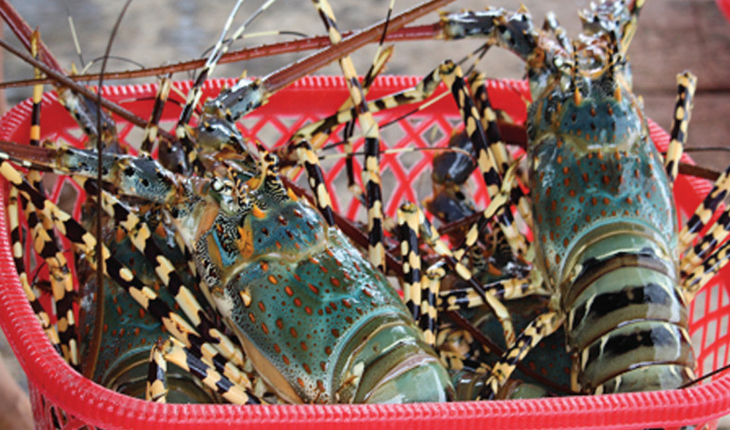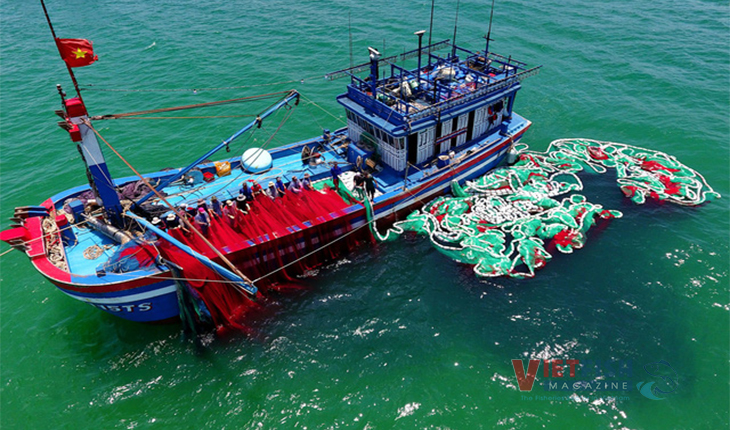Seafood industry stays strong amid challenges
2021 is the hardest year in the history with the outbreak of the COVID-19 pandemic; however, the seafood industry has remained resilient and displayed a remarkable breakthrough.
Strong recovery
Southern provinces started to suffer from the Covid-19 pandemic seriously in the middle of 2021 when many localities imposed the social distancing scheme, resulting in difficulties in transportation, and closure of wholesale markets. However, after a few suffering months due to the social distancing, enterprises and farmers came back to normal operations quickly.
Despite the overwhelming pandemic, the seafood industry has embraced themselves for the “new normal status”. According to the Directorate of Fisheries, the total output of aquatic species of 2021 reached 8.73 million tons, up 1% from 2020, with wild-caught species reaching 3.92 million tons, up 0.9% and farmed species reaching 4.8 million tons, up 1%. The output of brackishwater shrimp is estimated to reach 931 thousand tons (up 5.5% from 2020), with black tiger shrimp reaching 265 thousand tons and white leg shrimp reaching 666 thousand tons. The output of pangasius reached 1.484 million tons, down 4.5% as compared to the same period last year of 1.553 million tons. The total pangasius farming area reached 5.700 ha, equal to the same period last year. The export volume in 2021 is estimated to reach USD 8.89 billion, up 5.7% from last year of USD 8.41 billion, reaching 104.6% of the plan (USD 8.5 billion). If the export volume of fish meal and feed (USD 685.2 million) are counted, the total export volume of the seafood industry will be USD 9.57 billion in 2021, up 7.6% from the last year.
According to the Ministry of Agriculture and Rural Development (MARD), in 2021, Vietnam saw impressive results in sales of agricultural products, especially wood and wooden products, seafood, cashew, rubber, vegetables, rice, and coffee which displayed an export value of over USD 2 billion each. Seafood products ranked the second place with a worth of USD 8.89 billion.
Effort to overcome the COVID-19
So as to achieve impressive growth numbers, seafood producers have made great effort with the “three on site” and “one route-two destinations” strategy being strictly imposed. Many enterprises reduced 30% of their capacity to assure their employees of safe distance while working. Factories increased by 40% of the accommodation and traveling costs so that workers can go to work safely to fulfill the companies’ sale contracts.
Likewise, the Government has developed flexible and prompt methods to maintain the growth. For example, when sales of agricultural products were halted and production was disrupted especially in southern provinces, the MARD promptly worked with material producing areas and sales locations to tackle difficulties in transportation of agricultural products. After social distancing, enterprises put all their force to produce and rushed to fulfill orders at the end of the year and reopen the market upon the Resolution no.128 by the Government.
The success of the seafood industry in 2021 was attributed to the effort to open the market upon bilateral and multilateral trade negotiations by the Government with an aim to remove barriers, disclose standards in the market to boost national exports. Vietnamese products have been accepted by the most difficult markets in the world where high standards were imposed on imported products, especially seafood products. Vietnam’s enterprises took advantage of the FTA, especially the new signed ones such as CPTPP, EVFTA, and UKVFTA, which have helped diversify the market and exported products.
Speed up in 2022
The recovery and growth of seafood exports at the end of 2021 will leverage the exportation in 2022. Sales of Vietnamese seafood in the EU and the US are forecasted to continue to grow in 2022. The US’s imposition of further anti-dumping duty on Indian shrimp will pave an opportunity for Vietnam’s shrimp exporters.
Even though Vietnam’s exported whiteleg shrimp and black tiger shrimp are experiencing fierce competition in the US, the EU, China, Japan and the UK, Vietnamese shrimp ranked the first place for stable quality from frozen material shrimp to value added shrimp. To achieve the target of USD 4 billion worth from exports in 2022, the MARD plans to boost the production upon a supply chain and application of technology into hatchery production and commercial shrimp farming as well as promote the exportation through global trade exhibitions.
As for pangasius, the export volume in 2021 is estimated to reach USD 1.54 billion, up 3% from 2020. The increase was driven by higher demand for this species in the US, the EU, and China than before the Covid-19 pandemic. After the recovery in the second half of the year, sales of Vietnamese pangasius to China, the largest destination of Vietnamese pangasius, started to surge in March and April 2021. Exports of pangasius are forecasted to increase thanks to FTA, especially potential small markets such as Mexico, Brazil, Russia, Colombia, and Thailand. Pangasius exports are forecasted to reach USD 1.65 billion in 2022, up 7% from the previous year.
Nguyễn Anh – Hồng Hạnh
| >> Covid-19 pandemic will be a huge barrier against the development of the fisheries industry. The guideline of “safe adaptation” was formulated to not only deal with the pandemic but also make it a long-term strategy for the development of the fisheries. Thus, enterprises and farmers need to work together to overcome the pandemic, satisfy new requirements from the market, and adapt to the development of technology and climate change. |
Trần Đình Luân, General Director of the Directorate of Fisheries
The fisheries overcome difficulties remarkably in 2021
The fisheries overcame serious impacts of the Covid-19 pandemic remarkably in 2021. As a result, the production increased by 3.01% as compared to 2020. The Covid-19 pandemic resulted in a disruption in the production; however, the fisheries fulfilled its target in growth and exports. By October 2021, the fisheries industry made a forecast of around USD 8.4-8.6 billion worth from exports. However, the numbers started to grow during the last months of the year. Seafood exports reached over USD 910 million in November and are estimated to reach USD 900 million in December.
VŨ VĂN MINH, DEPUTY GENERAL DIRECTOR OF THE DIVISION OF INTERNATIONAL COOPERATION (MARD)
Specific solutions to exploitation is needed
The output of wild-caught species increased by 0.9% from the target of 3.8 million tons in 2021. It is forecasted that the output of exploitation will decrease sharply by 3.64%. The Directorate of Fisheries needs to work out a specific plan to achieve this target. We have proposed the standards of fishing ports and storm shelters in the plan report for 2022 so that the Directorate will establish official standards.
LÊ VĂN QUANG, CHAIRMAN OF THE BOARD OF MINH PHU SEAFOOD CORPORATION
Invest into infrastructure for shrimp broodstocks
Most shrimp broodstocks are imported, resulting in high prices, passive production time, and uncontrolled quality of shrimp adults. Broodstocks will be produced if the infrastructure is synchronized. The existing production areas and facilities are rehabilitated, unsynchronized every year. Thus, the facilities of shrimp broodstocks do not satisfy the requirements in production. Moreover, the drainage system in farming areas is also used for agriculture production, failing technical specifications in culture and being prone to disease outbreaks.
HỒ QUỐC LỰC, CHAIRMAN OF THE BOARD OF SAO TA FOODS JSC
Shrimp sector needs to tackle existing difficulties
In my opinion, the most difficult thing that the shrimp sector is suffering from is not trade barriers, but itself. For example, the numbering of farming facilities is too slow. Processing companies need to build a control system (with reasonable price) to trace the origin of products.






